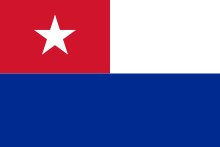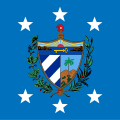Flag of Cuba
 | |
| Use | National flag and ensign |
|---|---|
| Proportion | 1:2 |
| Adopted | May 20, 1849 |
| Design | Five horizontal stripes of blue alternate with white with the red equilateral triangle based on the hoist-side bearing the white five-pointed star in the center. |
| Designed by | Narciso López and Miguel Teurbe Tolón |
The flag of Cuba consists of five blue and white alternating stripes, and a red equilateral triangle at the hoist with a white five-pointed star. It was adopted on May 20, 1849.[1][2]
History
After fighting for the Spanish Crown against the rebel armies of Venezuela, Narciso López moved from his native Caracas to Cuba. His involvement in anticolonial movements forced him into exile. In 1849 he moved to New York City, where he continued to advocate for an independent Cuba.
It is believed that when López awoke, one morning, and looked outside the window, he saw colours of the dawn sky. He could see "a triangle of red clouds announcing the dawn, and in the triangle shone the morning star Venus, while two white clouds departed from the triangle to divide into three blue stripes of shining heaven". Excited by what they had just seen, López turned to his friend, Miguel Teurbe Tolón, to tell of the event that unfolded.
Aside from this anecdotal version, an alternative story is that the flag was inspired by the U.S. flag (the U.S. expedition to Cuba commanded by Lopez in 1850 was intended as an annexation)
The three blue stripes represent the three departments in which Cuba was divided at that time, the white purity of ideals, the light; the red triangle, originating from the French Revolution – and the three ideals of liberty, equality and fraternity: red for the blood and the courage; the star was the new state that should be added to the United States.
The poet Miguel Teurbe Tolón designed the flag alongside López, based upon the story of López's vision. Emilia Teurbe Tolón, Miguel's wife, sewed the first flag. López and Tolón, together with José Aniceto Iznaga Borrell,[3] his nephew José María Sánchez Iznaga,[4] Cirilo Villaverde and Juan Manuel Macias, settled upon the final design for the flag of Cuba: two white stripes, three blue, a red triangle, a lone star. On it they swore to fight and lay down their lives to create an independent Cuba.
Narciso López used this same flag in 1850 to carry out his coup attempt to liberate Cuba from Spanish rule, which resulted in failure. The coastal town of Cardenas was the first town that saw the splendor of the lone star flag hoisted on May 19, 1850, in the taking of the city by Cuban rebels.
A year after the start of the Ten Years' War, the first Constituent Assembly of the Republic of Cuba met arms in Guáimaro, Camagüey Province. The debate focused between two flags of great symbolism, the Demajagua – which was very similar to the Chilean flag – created by Carlos Manuel de Céspedes to give start to the war of independence, and the Lone Star of Narciso López, the latter being chosen since Narciso López had taken the first step for the freedom of Cuba. The Demajagua flag not was scrapped, but instead, was put in the sessions of the House of Representatives and retained as part of the national treasure.
On the morning of May 20, 1902, the day of the inauguration of the Republic, Generalissimo Máximo Gómez had the honor of hoisting the flag on the flagpole of the castles of the Tres Reyes del Morro, Havana; thus sealing with this act the end of the Cuban revolution, the end of struggle for Cuban independence, and at the same time justifying the sacrifice that so many offered to make this dream become reality.
Both the flag and the coat of arms were designed by Miguel Teurbe Tolón. The design of both specifications were established by decree of the first President of Cuba, Tomás Estrada Palma, on April 21, 1906, and have remained unchanged since then.
Subsequent use of the flag
In April 1869, Narciso López's flag was designated the national banner by the Congress of the Republic of Cuba. López's flag was the model for the flag of Puerto Rico adopted in 1892 by the Puerto Rican Revolutionary Committee, a pro-independence group that worked under the auspices of Cuban Revolutionary Party.
After the United States seized Cuba from Spain during the Spanish–American War, the Stars and Stripes flew from January 1, 1899, until independence was granted. On May 20, 1902, the Cuban national flag was hoisted as a symbol of independence and sovereignty. It has been used ever since, remaining unchanged after the Cuban Revolution of 1959. During the revolution, Cuban president Fidel Castro's 26th of July Movement created a party flag equally divided in red and black like the Angolan national flag usually in horizontal stripes and often with inscriptions, which is often flown on public buildings.
Specifications
.svg.png)
The Cuban flag is at a length-to-width ratio of 2:1. The blue and white alternating stripes are of equal width. The red chevron is in the shape of an equilateral triangle that does not extend to the middle of the flag. The star within the chevron has a radius that is 3⁄20 the length of the hoist. Its middle is halfway up the flag.
Other flags
 Flag of the 26th of July Movement
Flag of the 26th of July Movement Naval Jack of Cuba, a.k.a. Flag of Yara or Flag of La Demajagua
Naval Jack of Cuba, a.k.a. Flag of Yara or Flag of La Demajagua Standard of the Prime Minister of Cuba (1959–1976)
Standard of the Prime Minister of Cuba (1959–1976) Standard of the President of Cuba
Standard of the President of Cuba
See also
- Coat of arms of Cuba
- Flag of Puerto Rico, a similar flag with the red and blue reversed, and shorter length
- Estelada
References
- ↑ "flag of Cuba". britannica.com.
- ↑ "History of Cuban flag and emblems". cubaflags.com.
- ↑ Jorge Iznaga. JOSE ANICETO IZNAGA BORRELL Iznaga Genealogy (IZNAGA - 1420 - Present), Retrieved 5 December 2012.
- ↑ Jorge Iznaga. JOSE MARIA SANCHEZ IZNAGA Iznaga Genealogy (IZNAGA - 1420 - Present), Retrieved 5 December 2012.
External links
| Wikimedia Commons has media related to Flags of Cuba. |
- Cuba at Flags of the World
- Cuba Flags—A historical insight into the flag and emblems of Cuba
- http://www.flagscorner.com/cuban-flag/